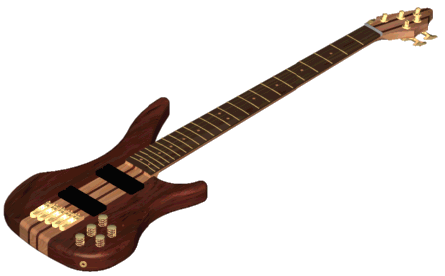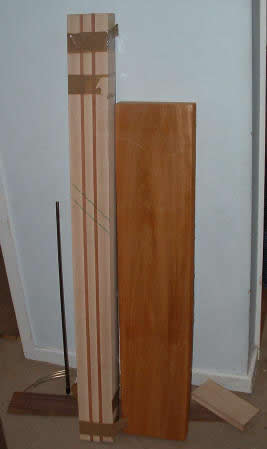
 Bass Madness
Bass Madness
28 March 2018
The Design
I decided that I would do as much design and planning as I could before I cut wood. This involved some research into available parts. While most manufacturers and suppliers were very helpful, some were not very good at providing design information. I had difficulty completing the detail design. Some dimensions were dependent on some of the hardware, more about this problem later. I needed to buy a very expensive bridge to obtain the necessary measurements to complete the design. I was intending to wait until I had completed the woodwork before I took this step, in case I made a total hash of things. But I needed the minimum and maximum string heights. I could get around this with some tinkering later but I wanted to make a good job. More about the bridge in later sections.

I used AutoCad 2000 to produce a detailed 3D model of the guitar. The results of the assembly, minus the strings are above.
The spec for the guitar is as follows:
- Scale: 864mm (34");
- Fingerboard: 24 fret, Rosewood 300mm (12") radius;
- Neck: five piece Maple and Bubinga through neck;
- Body: Mahogany;
- Machine Heads: Gotoh GB70E, gold;
- Bridge: Shadow single string with piezo pickups, gold;
- Pickups: Two EMG CS active
- Electronics: Volume for each of the three sets of pickups and active treble and bass controls.
 I originally planned a three band equaliser but there were too many knobs. Most amplification these days has sufficient equalisation, so I decided that I didn't need to duplicate this on the guitar. Like most active guitars, I have integrated an off switch in the jack socket. To avoid needing to switch the amplifier off, to prevent buzzes from a detached lead, when not playing. I have added an additional switch close to the control knobs. This was a later brainstorm and is not shown on the CAD drawing. I designed the electronics myself.
I originally planned a three band equaliser but there were too many knobs. Most amplification these days has sufficient equalisation, so I decided that I didn't need to duplicate this on the guitar. Like most active guitars, I have integrated an off switch in the jack socket. To avoid needing to switch the amplifier off, to prevent buzzes from a detached lead, when not playing. I have added an additional switch close to the control knobs. This was a later brainstorm and is not shown on the CAD drawing. I designed the electronics myself.
Well that's what I intended to build. I finally committed myself and ordered the wood from David Dyke Luthier's Supplies in East Sussex. It arrived just as I expected; a very heavy pile of wood.